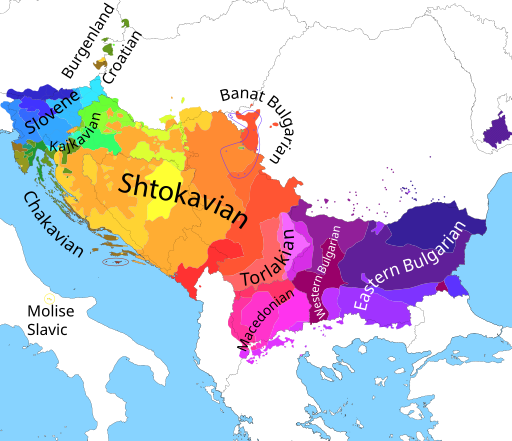Archivo: South Slavic dialect continuum

Descripción: A map of geographical extension of dialects of languages that belong into South Slavic group (Slovene, Serbo-Croatian, Macedonian, Bulgarian). Bigger groups of dialect are named. Slovene and Kajkavian are further split by thin grey lines to indicate dialects. Legend: Slovene: Carinthian dialect group Upper Carniolan dialect group Rovte dialect group Littoral dialect group Lower Carniolan dialect group Styrian dialect group Pannonian dialect group Kajkavian: Goran dialect Prigorje dialect Turopolje–Posavina dialect Zagorje–Međimurje dialect Križevci–Podravina dialect Lower Sutlan dialect Chakavian Buzet dialect Northern Chakavian Middle Chakavian Southwest Istrian Southern Chakavian Southeastern Chakavian (circled) Shtokavian Slavonian dialect East Bosnian dialect Molise Slavic (circled) Younger Ikavian dialect Eastern Herzegovinian dialect Šumadija–Vojvodina dialect Smederevo–Vršac dialect Kosovo–Resava dialect Zeta–South Raška dialect Torlakian (names given by SerboCroatian linguists): Prizren–South Morava dialect Svrljig–Zaplanje dialect Timok–Lužnica dialect Macedonian Northern dialects Western dialects Central dialects Eastern dialects Southern dialects Bulgarian Southwestern Bulgarian dialects Northwestern Bulgarian dialects Western Rup dialects Central Rup dialects Thracian dialect Strandzha dialect Balkan dialects Moesian dialects Banat Bulgarian (circled)
Título: South Slavic dialect continuum
Créditos: The map is a collection of many maps of regional dialects of different languages. Therefore, the borders between languages might not match at all places the one normally present for that language because it overlaps with a border from other language's map. This map was made only by overlaying screenshots of maps, so it should not be used for precise determination. Note that in some areas other (non-slavic) languages might also be spoken or even prevailing (e. g. Kosovo, Hungary and Romania) The coast and the border were taken from Eurostat (https://ec.europa.eu/eurostat/web/gisco/geodata/reference-data/administrative-units-statistical-units/countries). Map of Slovene dialects and Slovene-Croatian border is based on this map. Borders between Serbo-Croatian supradialects are based on (Kapović, 2015 pp.50–51). Chakavian borders are based on (Kapović, 2015, p. 43), Schakavian, Torlakian and Shtokavian are based on (Kapović, 2015, pp. 40–41). Kajkavian is based on Lončarić's map with addition of (Kapović, 2015 p. 46). Burgenland croatian is based on this file while Molise Slavic is based on its Wikipedia page as of April 2023. Border with Macedonian/Bulgarian is based on Kapović's map. Kapović, Mate (2015) (croata) Povijest hrvatske akcentuacije, Zagreb: Zaklada HAZU, p. 50 ISBN: 978-953-150-971-8. Bulgarian is based on the interactive map. See also the talk on South Slavic languages and creator's talk page for further updates.
Autor(a): Garygo golob
Términos de Uso: Creative Commons Attribution-Share Alike 4.0
Licencia: CC BY-SA 4.0
Enlace de Licencia: https://creativecommons.org/licenses/by-sa/4.0
¿Se exige la atribución?: Sí
Usos del archivo
La siguiente página enlaza a este archivo:

